GUIDE Camino Sanabrés: A scenic and peaceful camino
Camino Sanabrés is a wonderful camino with lots of natural beauty. There are relatively few pilgrims – just imagine the spirit and atmosphere of Camino Francés 25 years ago
Facts about Camino Sanabrés
Total length: 370 kms
Starting point: Granja de Moreruela
Ends in: Camino de Santiago
Stages: 13-19
We are sharing our best tips and recommendations for Camino Sanabrés.
We walked this camino in three parts: with a start in Granja de Moreruela to Puebla de Sanabria in July 2018, on to Ourense in April 2019 and the last part from Ourense to Santiago in October 2018. Three equally wonderful camino seasons: Spring with snow and a blossoming heather, summer with very blue skies and very high temperatures and autumn with beautiful colours and warm days.
Shorter stages with more time to enjoy the walk (19,6 kms pr. day)
Check out our stages and the albergues (25,6 kms pr. day)

How many pilgrims walk Camino Sanabrés?
Camino Sanabrés is a camino by itself, but also one of the possible endings of the camino Via de la Plata and Camino Mozárabe, which both have their starting points in southern Spain. There are not that many pilgrims on these routes – less than 4 % of all pilgrims arrive to Santiago de Compostela from these caminos. Camino Sanabrés is a peaceful camino a lot like Camino Francés 25 years ago. No need to worry about finding a bed at any albergue. No need to get up early.
The locals say Sanabrés is a new camino – but new in Spain still means more than 800 years of pilgrim history!
Check out the traffic on the different caminos in Spain
Even though Sanabrés is a peaceful camino, you’ll meet enough pilgrims to experience a classic pilgrim society if you walk between April and October. In the winter the route is more of a lonely walk.
We were ten pilgrims following the same stages in July. A bit less in October. Almost every pilgrim on this route is an experienced pilgrim. You can tell from their camino patches and camino tattoos!
How’s accommodation along this camino?
Just like on the other caminos in Spain you’ll find a variety of accommodation along Camino Sanabrés. A lot of them are donativo albergues where it is up to you to decide what you are able and willing to pay. In general, the albergues along this camino are the cheapest ones we have encountered on any camino: 3-5 euros for a bed in a dormitory. Another aspect that makes this camino special is how often you find very small albergues with space for only 4-5 pilgrims. NB. Chances of having to suffer through other people’s snoring is minimal! If you prefer staying at small rural hotels, this camino is doable with that, but some stages might be a bit long.
See our honest opinion on the albergues and hostals we tried
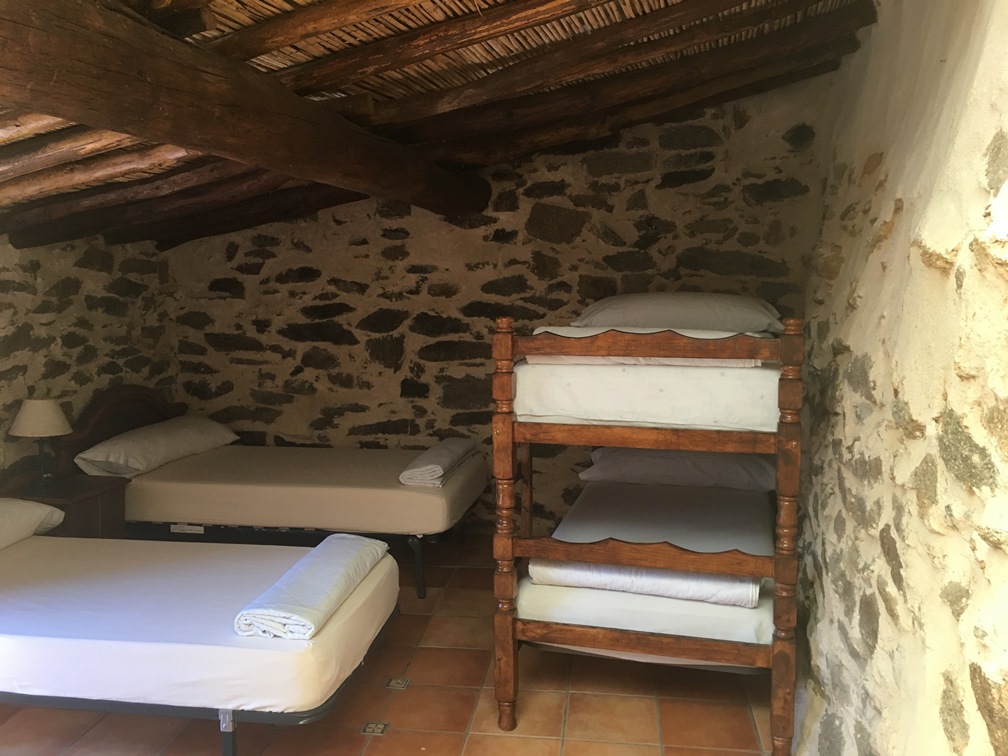
Camino Sanabrés has quite a few self-service albergues, meaning it’s an albergue without any hospitalero or check in area. In these albergues, you don’t get a bed sheet and cushion cover, so it’s a good idea to add to your packing list for this camino.
How long are the stages?
Camino Sanabrés does not have nearly as many services as Camino Francés. Actually people say Camino Sanabrés today is like Camino Francés 25 years ago, before the pilgrim numbers exploded. Luckily pilgrim tourism hasn’t reached Camino Sanabrés yet. As a consequence, you don’t find accommodation every 5 kms. 15-20 kms is more likely. And it can be tricky, as you may have to walk longer than you wish some days. Especially if you only want places with a grocery store or a restaurant.
Is it easy to buy food along the camino?
Well – honestly, no. Especially Sundays are difficult, and all the stores close for the siesta. So some days you pass by a grocery store to no avail, if you walk during the siesta hours of 2-5 PM. On Sundays both restaurants and shops are likely to be closed:
The bars usually don’t open until 9:30-10:00, unless you’re in a larger city. Your first cup of coffee’s gonna taste like heaven:
What do I do about food?
When we realized how few services this route has, we bought the Wiselys app, which made it much easier to plan when to shop.
Camino Sanabrés also means you may have to carry extra weight. Some days we had to carry dinner, breakfast and lunch with us. Baguette, smoked ham (jamón ibérico), patées and some cheese can last until next day in a backpack. Tomatoes too.
Which season is best?
You can walk Camino Sanabrés all year round, but be prepared for some closed albergues in the winter and snow filled paths that can be difficult.
In April we enjoyed the blossoming heather and the melting snow – luckily no new snow.
The weather changed a lot during the day. During spring, the melting water from the snow comes down the mountains, so spring can be a muddy season. In July we only saw the dried out memories of mud:
Camino Sanabrés is seriously hot during the summer, and some choose not to walk in July and August only because of this. We gave it a try cause we usually don’t have any problems with hot days. We don’t walk the camino during the summer because of the high number of pilgrims that do – but this was really not a problem on the Sanabrés camino.
Prepare yourself for the sun and heat if you want to walk Sanabrés during the summer. We saw some serious sun burns.
I was really pleased to have my sun visor with me. Sun glasses can be irritating when you walk. And for an extra layer of protection for my shoulders I put my Turkish towel on the sun visor making me look like more like a Bedouin than a pilgrim. My own place in the shadow. My husband Torben wore ultrathin outdoor shirts and a thin cap.
We drank a whole liter of water before starting off in the morning and carried a liter and a half each. When we woke up early, we left early to enjoy the morning hours that weren’t that hot.
October is a really nice month for walking the Sanabrés: You will still have warm days, and can enjoy the autumn vegetation and the sight of chest nuts on the path.
How is the camino sign posted?
Along most of the route Camino Sanabrés we found the best sign postings of any camino we’ve walked. You really don’t need a map. If you’re leaving before dawn, the Wiselys app is a good app to have. You have the map online, and you’re the blue dot. No worries about missing yellow arrows in the dark.
There are two exceptions to the great sign posting though:
- The construction of a high speed railway to Galicia causes signposting problems between Puebla and Lubián. If you get lost here, just walk back and start again – that is the safest way, as you know what the trail brings. Don’t take any shortcuts!
- There is extremely little signposting after the church in La Tuiza until La Portela a Canda on the border of the regions Castilla y León and Galicia. The principle is: You go up-up-up. Follow the stream upwards, and you’ll reach the mountain pass.
Is Camino Sanabrés a good camino for a newbie?
Camino Sanabrés has very few debutants. The few services and the length of the usual stages can be stressful to a first-time pilgrim. But on the other hand: “The camino provides” as they say… You will always find a way out and learn how to plan your day. Help is never far away. In return the Camino Sanabrés rewards you with fabulous views:
Is Camino Sanabrés good when walking with children?
Again no – unless you are an experienced pilgrim yourself, so you don’t end up having to skip meals due of poor planning. If it is your own first camino, you will need less planning and have fewer worries when walking with children, if you pick a camino with more services on route like Camino Francés og Camino Portuguese central route. The path itself on Camino Sanabrés is no problem for a child, though. But the long distances might be:
Are there any attractions along the route?
If you have time when you arrive then take a walk to the legendary monastery Santa Maria de Moreruela. The biggest and most important monastery of Spain. It is about four kms each way from Granja de Moreruela.
Which cities are most interesting along this camino?
It is magical how the camino reveals the simple beauty of even the smallest, humblest villages, when you open your mind. So never hesitate choosing to stay in the small villages. That being said, Puebla de Sanabria and Ourense are large and beautiful cities really worth planning to stay in when you walk Camino Sanabrés.
Puebla de Sanabria with the castle 239 steps above the river Tera has given the whole camino its name. Carefully restored historical center and views of the surrounding landscape. Groups of Spanish tourists come here, but the city is still inhabited and authentic and not merely a tourist setting!
Did you say hot springs?
Ourense, the largest city along the route, is famous for its hot springs. A special experience your tired pilgrim feet really deserve by now! There are three different places to try the hot springs: Chavasqueria is the most central one – free and used primarily by locals. Next time we will go there when the sun sets over the river and the cities lights are turned on. Should be a spectacular view.
There are two larger and more luxurious hot springs in Ourense – you can reach them both with the little tourist train (1 euro)
Is it possible to take a swim?
Even though Camino Sanabrés is not a coastal camino, there are swimming possibilities along the path. Not only in Ourenses hot springs, but also the freezing cold, crystal clear rivers along the way. Look for “playa fluvial”. This is from the recreative area “La Barca”:
How is the underlay?
We recommend you walk Camino Sanabrés in footwear you have tested and know works for your feet during long distances. Generally this camino has more passages with dirt tracks, uneven nature paths, stones and rocks than other caminos. Beware some of the stages can be longer than you are prepared for. There are hard gravel and asphalt roads as well. This camino calls for really good footwear. I regret walking it in July in sandals that did not support my foot properly. I ended up with plantar fasciitis – every pilgrim’s nightmare.
Is it possible to find baggage transport along Camino Sanabrés?
Due to the relatively small numbers of pilgrims walking Camino Sanabrés, baggage transport is only organized on the last part from Ourense and the last 100 kms to Santiago. From there on it works very well with Spanish post service Correos – five euros a day. If you need baggage transport before Ourense, you can choose to stay at hostels that offer baggage transport. You usually find them advertising in the cafés and albergues along the route:
Taxa is an option – usually 20-25 euro a day.
More about baggage transport on the camino
How do I reach the starting point of Camino Sanabrés?
Flying to Madrid is easiest for this camino. From the airport there is a two and a half hours drive. I usually book a private trip with a Spaniard via the car pool service www.blablacar.co.uk. You can check out how popular each driver is and communicate before booking. Secure payment with credit card. Look for the route Madrid – Benavente, and ask to be set off in Granja de Moreruela.
Driving with a Spaniard is usually half the price of buses and trains. The drivers usually announce their trips very late – so be sure to check the website 1-3 days before you arrive. In Granja the albergue is the only accommodation. You find the hospitalera in Tele-Bar on the opposite side of the road. This means it is possible to arrive late – the bar is open. You cannot book, but remember to trust that “the camino provides”.











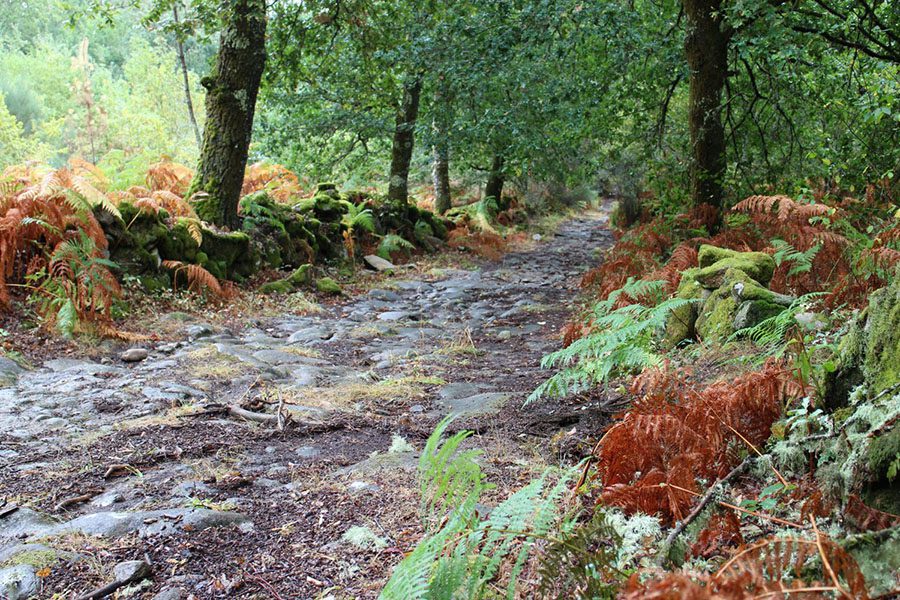






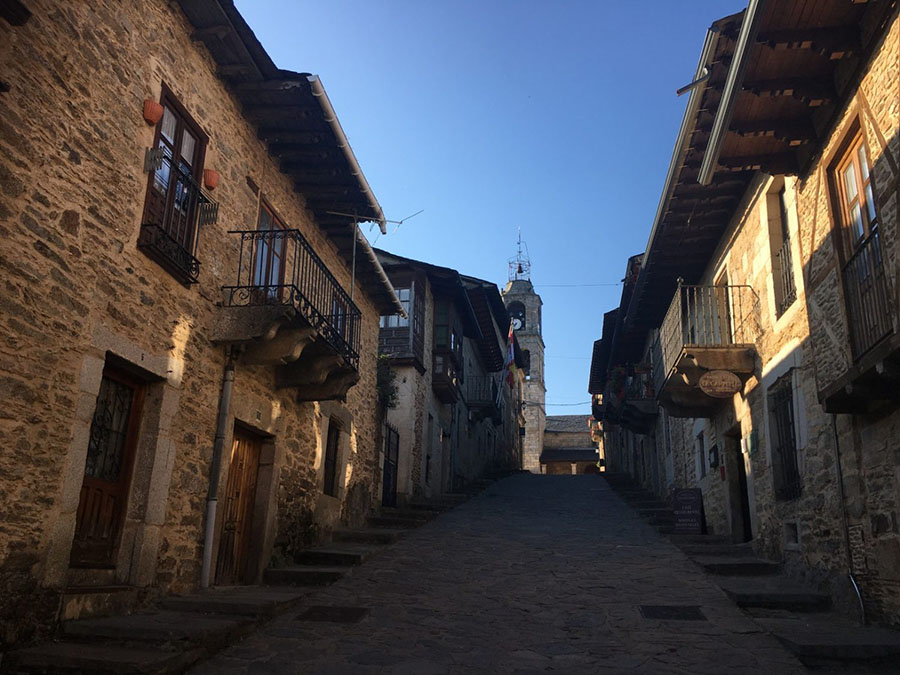




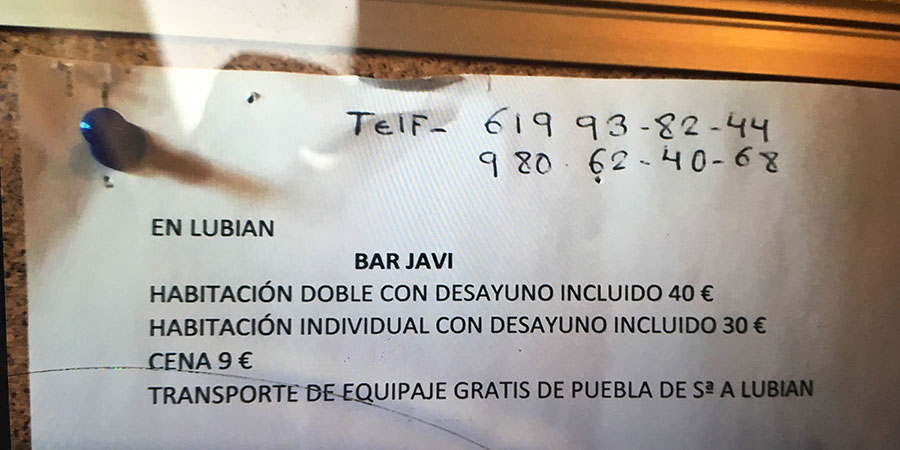
















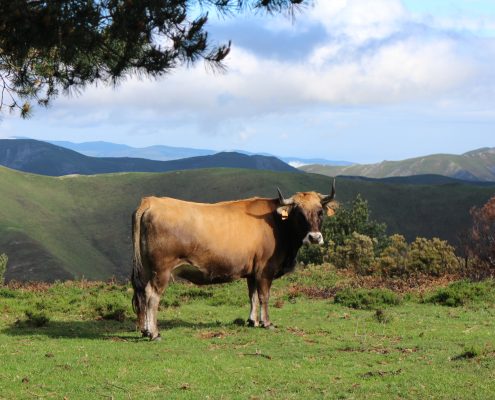


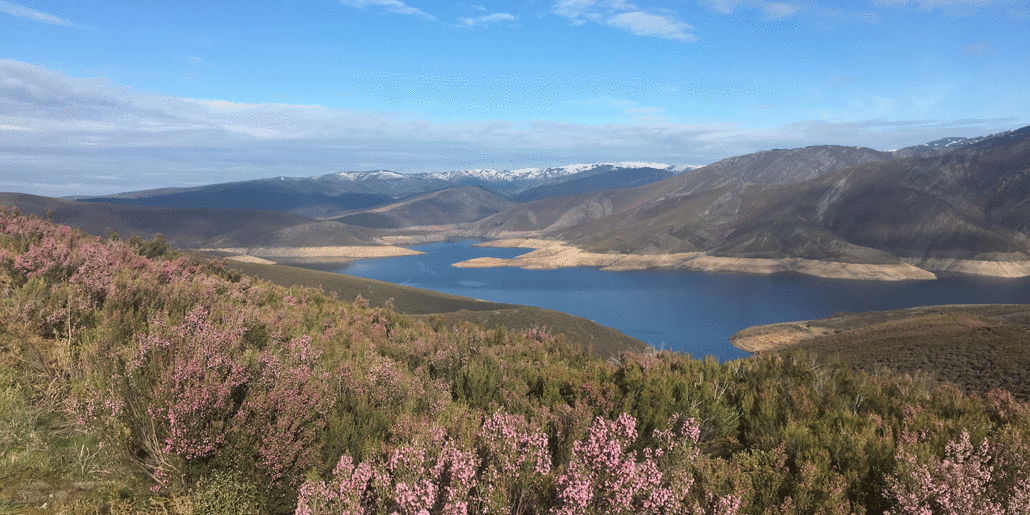






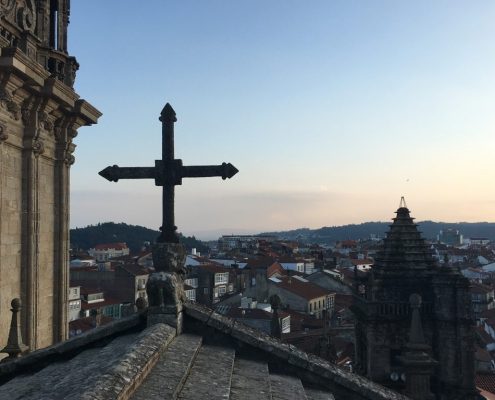











Hi there,
I am from Belgium.
Going on my first Camino from the 22nd of april till 27th of May. I arrive in Madrid.
I like solitude so picked the Sanabres. I do like your story of shorter hikes. Very useful for me
I am thinking to do it as follows: start from Ourense (going there by train) and walk to Santiago first. That will give me some Camino experience + my Camino certificate + it will be quiter on this last 100km part as it is earlier in the season. Maybe colder still?
Then I would take public transport to the 100km mark of any Camino I see fit and start walking towards the beginning of that chosen Camino. F e from Ourense back towards Zamora. That gives me the additional advantage that I can stop the walking whenever me, or my body, have enough and take bus/train back to Zamora and Madrid.
I’ll be 75 in July.
What is your opinion on this idea?
Greetings,
Walter
We want to walk the Camino Sanabrés from Vérin in the spring of 2024. Can you please tell me where inns are located, or at least where I can find them. Booklet possibly?
We are also considering walking the Portugues Interior from Vérin. Here we are also looking for places to stay overnight.